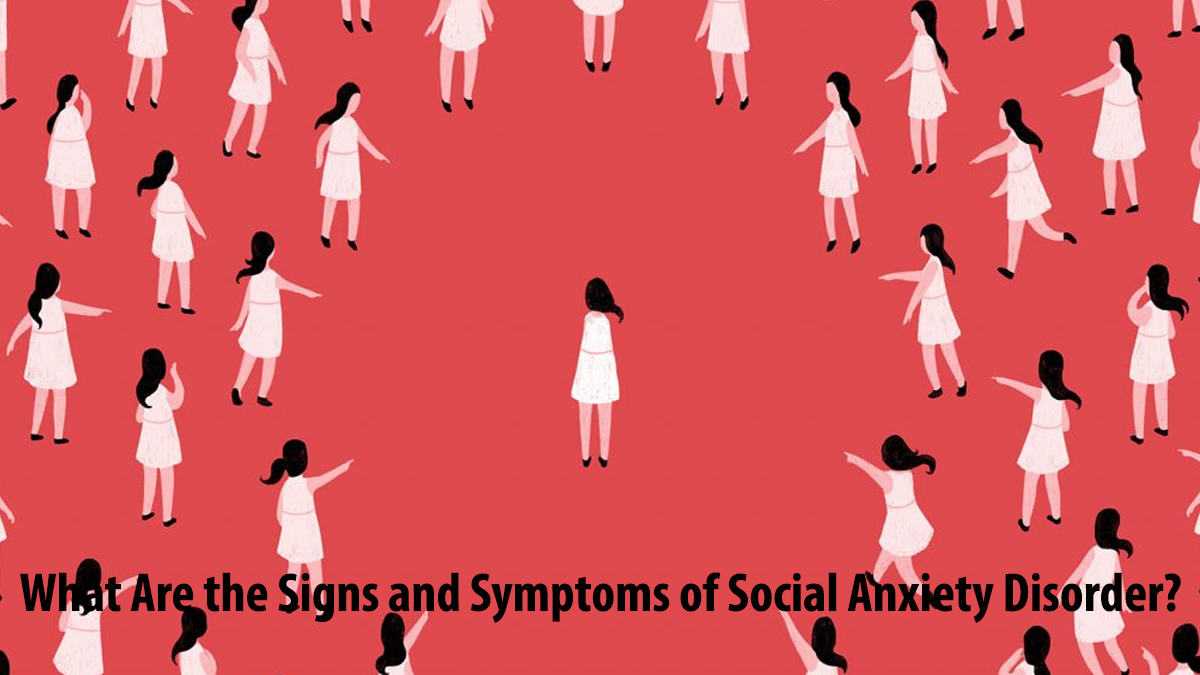In a nutshell, social anxiety disorder is a persistent, excessive fear of being subjected to public scrutiny or embarrassing behavior. Its symptoms far exceed the normal level of shyness and cause substantial social impairment. It affects the sufferer’s ability to engage in a wide range of social interactions, including small groups, dating, restaurants, and interviews. Here are some of the most common signs and symptoms of social anxiety disorder.
Signs and Symptoms of Social Anxiety Disorder
A person with social anxiety disorder experiences certain behaviors, thoughts, and feelings in various situations. Some people have specific signs and symptoms, while others have symptoms across all types of social situations. For example, they may avoid eye contact and maintain stiff body posture when around others. People with social anxiety disorder often feel self-conscious in public. For these people, the symptoms of social anxiety are particularly noticeable. A therapist can help them identify these signs and symptoms and prescribe the most appropriate treatment for them.
Treatment for social anxiety disorder is important because of its association with other mental health problems. When properly diagnosed and treated, this disorder can significantly reduce the symptoms of depression, substance abuse, and suicidal ideation. If a person does experience the symptoms of social anxiety disorder, he or she may choose to seek counseling, medication, or exposure therapy. Learning how to recognize the signs of social anxiety disorder can help you recognize them sooner.
During childhood, a person with social anxiety may be shy or withdrawn. As a teenager, they may fear meeting new people, giving public speeches, or attending work presentations. They may also experience facial disfigurement or stuttering. In rare cases, people with social anxiety disorder may develop Parkinson’s disease, which increases the feelings of self-consciousness and can trigger symptoms. Lastly, drug and alcohol abuse is often associated with social anxiety disorder.
What is Social Anxiety Disorder?
To find out if you suffer from social anxiety disorder, you should see a doctor or mental health provider. They will perform a physical exam and conduct a discussion of your symptoms. The doctor can prescribe medication or psychotherapy, depending on your condition. Before you begin any treatment, you should know the possible side effects. A physical examination can also reveal underlying medical conditions or medications you may be taking. You can also use a diary to keep track of your symptoms and discuss them with your healthcare provider.
Cognitive behavioral therapy is a form of treatment that involves confronting fears and developing confidence. It may involve role-playing or social skills training. Studies show that cognitive behavioral therapy is effective in improving symptoms of social anxiety disorder. Researchers have discovered that cognitive behavioral therapy, also known as CBT, causes positive changes in the brain. Among the benefits of CBT is that it reduces the size of the emotional processing areas of the brain.
The symptoms of social anxiety disorder are different for each person. Some people with the condition venture out frequently, while others remain cloistered in their homes or reclusive. They appear distracted, jumpy, and stressed. While they may appear to be relaxed and unaffected on the outside, their thoughts about social situations are a sign of their disorder. If you experience any of these symptoms, it is important to seek treatment.
What are the Symptoms of Social Anxiety Disorder?
People suffering from social anxiety disorder often experience fear and anxiety that is too great for them to handle. These symptoms make even the simplest social engagements a major challenge. Other symptoms include trembling, blushing, sweating, and nausea. They may also avoid certain places and events. For this reason, it is important to seek professional help as soon as possible. In addition to these common mental symptoms, social anxiety can also affect physical functioning.
People suffering from social anxiety should visit their GP to get diagnosed. Although it can be scary to go to the doctor, it’s important to remember that there are treatments for the disorder, including medication and cognitive therapy. It’s never too early to seek help, and your GP understands that social anxiety can be difficult to discuss, but they will make you feel comfortable and explain the different options available to you.
Some people with social anxiety don’t seek treatment because they think they are “just shy” or “timid” or because it’s part of their personality. If you are experiencing these symptoms regularly, however, it is time to seek professional help. Sometimes social anxiety is a genetic disorder and runs in families. Researchers don’t know why some members of a family have social anxiety while others don’t. The disorder can be caused by several factors, including an imbalance of serotonin in the brain, an overactive amygdala, and genetics and temperament.
Physical Symptoms
A person suffering from social anxiety disorder may experience several physical symptoms. A person with this disorder may have a constant fear of social situations. Some people may suffer from limited anxiety when they’re eating in front of others, while others may have extreme symptoms in any situation. Some physical symptoms may be caused by an imbalance of serotonin, which regulates mood. Another reason can be an overactive amygdala.
If left untreated, social anxiety can become chronic and lead to other health problems, such as substance use disorders. The good news is that treatment is available and it doesn’t have to control a person’s life. Treatment options include therapy, medication, and lifestyle changes. While social anxiety is a debilitating condition, many people with social phobia can find relief from their symptoms. Here are some ways to find a treatment option for your social anxiety disorder.
People with social anxiety disorder often have intense fears of being criticized or judged by others. They are often unable to fully participate in social situations and may avoid them at all costs. Many sufferers self-medicate with drugs or alcohol, which can lead to an addiction. In any social setting, a person with social anxiety disorder is afraid of being judged or negatively assessed by others. The person experiencing anxiety attacks almost always avoids the situation, causing them considerable distress.
Emotional and Behavioral Symptoms
Despite being one of the most common mental health conditions, general practitioners have poor recognition rates for social anxiety disorder. The reasons for this may be related to a lack of well-defined care pathways, a lack of awareness, and stigma surrounding the condition. The following are some common behavioral and emotional symptoms of social anxiety disorder. They may also be a result of a lack of knowledge or misdiagnosis.
An extreme form of social anxiety can lead to trembling. Often times, excessive sweating is a symptom of an anxiety attack. Sweating is a physiological reaction to fear. Another physical symptom of social anxiety disorder is an upset stomach. Digestive irregularities and the fight or flight response to the fear of being judged may also be symptoms of social anxiety disorder. Fortunately, social anxiety disorder is often treatable.
While treatment for social anxiety disorder is available, a small percentage of people with the condition seek professional help. This is often because of the stigma attached to mental health services. Many people suffer for years before they finally seek treatment. A GP will likely discuss their symptoms with you and try to put you at ease. You will need to make an appointment to get an accurate diagnosis. If you’re struggling, seek help as soon as possible.
The Bottom Line
Having trouble socializing in groups or getting along with people? If so, you may be suffering from social anxiety disorder. The good news is that there are many methods available to help you overcome this disorder and get back to being yourself. Start by defining your goals and visualizing what you want to accomplish. If you can visualize yourself in a social setting, this will motivate you to change. Also, you can start thinking about ways to use your talents and interests.
The main symptom of social anxiety disorder is excessive fear of certain social situations. These situations can be any social encounters where a person is expected to interact with others. This disorder often manifests itself in the form of anticipatory anxiety and situational avoidance. Anxiety sufferers may avoid or tolerate social situations with a high level of discomfort. If the symptoms of social anxiety disorder occur when a child is in a peer situation, this symptom is more likely to develop.
The cause of social anxiety is unclear. Although the disorder has no clear cause, researchers believe that a variety of factors are to blame. The typical age for onset of the disorder is between 10 and 19 years old. Moreover, the disorder may affect a person’s ability to socialize, perform well, and enjoy life. While social anxiety disorder is a mental illness, it is curable. Like any other disorder, it is caused by triggers. Certain scents, thoughts, or brainwave patterns may lead a person to experience social anxiety.

